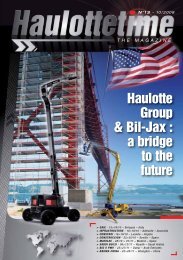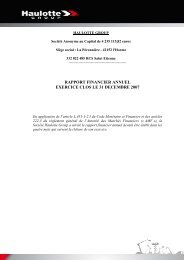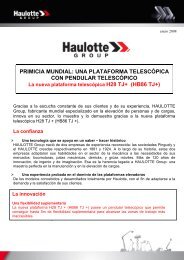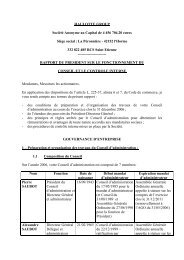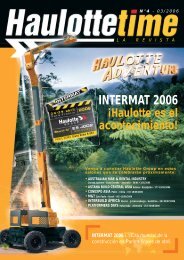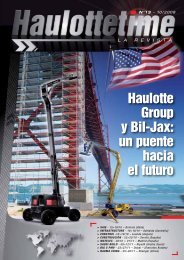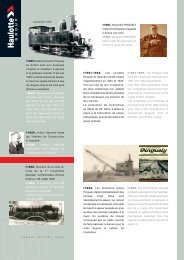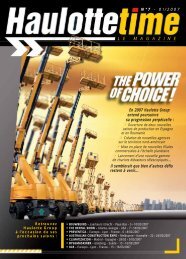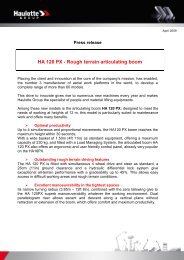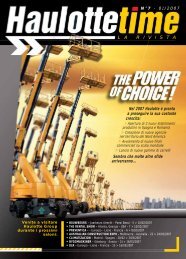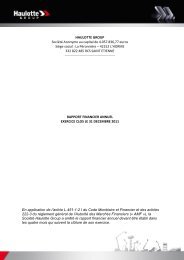2007 - Pinguely Haulotte
2007 - Pinguely Haulotte
2007 - Pinguely Haulotte
Create successful ePaper yourself
Turn your PDF publications into a flip-book with our unique Google optimized e-Paper software.
<strong>2007</strong><br />
annual report # p91-92<br />
Consolidated financial statements of December 31st, <strong>2007</strong><br />
The purchase and sale of financial assets<br />
(including derivative financial<br />
instruments) are recognized on the<br />
settlement date.<br />
Information on derivatives used by<br />
<strong>Haulotte</strong> Group is provided in a separate<br />
note (note 4).<br />
3.6 Inventory and work in progress<br />
Inventories are stated at the lower of cost<br />
and net realizable value:<br />
- Raw materials and supplies are<br />
recognized at the purchase price. The<br />
cost of finished products and work in<br />
progress includes direct production<br />
costs and production overhead (based<br />
on normal operating capacity). The<br />
inventories are measured using the<br />
weighted-average cost method;<br />
- The net realizable value is the estimated<br />
selling price under normal operating<br />
conditions less costs required to sell or<br />
recondition the good.<br />
3.7 Trade receivables<br />
Receivables are initially recognized at fair<br />
value of the amount paid or receivable.<br />
They are subsequently measured at<br />
amortized cost calculated according to<br />
the effective interest rate method, less<br />
provisions for impairment.<br />
When there are serious and objective<br />
evidence of collection risks, a provision<br />
for impairment of trade receivable is<br />
recorded. This provision represents the<br />
difference between the asset’s carrying<br />
amount and the estimated resale value<br />
of the item representing the receivable.<br />
This resale value is estimated on the basis<br />
of a professional valuation. The provision<br />
is recorded in the income statement as<br />
“selling expenses".<br />
a) Sales with guarantees<br />
In line with industry practice, <strong>Haulotte</strong><br />
Group S.A. grants guarantees to financial<br />
institutions proposing financing to Group<br />
customers. Under such arrangements,<br />
<strong>Haulotte</strong> Group transfers equipment to<br />
the financial institution that in turn<br />
proposes the end user customer one of<br />
two options:<br />
- The credit sale of the equipment<br />
through a loan,<br />
- Conclusion of a finance lease.<br />
In both cases, <strong>Haulotte</strong> Group SA grants<br />
guarantees to this financial institution.<br />
The guarantees granted by <strong>Haulotte</strong><br />
Group are of the following nature:<br />
1) Commitments to assure lease<br />
payments: <strong>Haulotte</strong> Group S.A.<br />
guarantees the financial institution<br />
payment if the debtor defaults and<br />
pays said institution upon the first event<br />
of default the entire outstanding capital<br />
balance owed by the defaulting client.<br />
In such cases, the Group will repossess<br />
the equipment for resale on the market<br />
for used equipment; and/or;<br />
2) Risk pool commitments: for each lease<br />
contract signed, the Group contributes<br />
to a guarantee pool to cover future<br />
risks of customer default;<br />
3) Commitments to purchase the residual<br />
value at the end of the lease: <strong>Haulotte</strong><br />
Group grants a guarantee to<br />
repurchase of the residual value of the<br />
equipment to certain financial<br />
institutions at the end of the lease<br />
agreement concluded between the<br />
entity and the Group customer.<br />
The first and second transactions<br />
described above are analyzed in<br />
substance:<br />
- For credit sales of equipment by the<br />
financial institution to the end customer<br />
as a loan granted to the end customer<br />
by <strong>Haulotte</strong> Group, with the contract<br />
transferred to the financial institution<br />
to obtain financing for the sale;<br />
- For finance lease agreements between<br />
the financial institution and the end<br />
customer as a finance lease between<br />
<strong>Haulotte</strong> Group and the end customer,<br />
with the contract transferred to the<br />
financial institution to obtain financing<br />
for the sale.<br />
Analysis conducted according to the<br />
provisions of IAS 39 has indicated that<br />
because of the guarantees granted by<br />
the Group, most of the risks and rewards<br />
associated with the receivable payable<br />
by the end client have not been<br />
transferred to financial institutions. In<br />
consequence, in accordance with IAS 17<br />
(or IAS 18) and IAS 39, for the two types<br />
of commitments mentioned above the<br />
Group has recognized receivables from<br />
financing arrangements and financial<br />
debts for the balance payable by the end<br />
client to the financial institution. These<br />
receivables and payables will be<br />
eliminated as the client makes the lease<br />
payments to the financial institution.<br />
In contrast, for the third type of guarantee<br />
(repurchase commitments at the residual<br />
value) the credit risk and the risk of a<br />
delayed payment by the customer are<br />
fully incurred by the financial institution.<br />
In addition, <strong>Haulotte</strong> Group systematically<br />
offers customers the option of purchasing<br />
the equipment concerned at a price<br />
corresponding to this residual value.<br />
Available market data indicates that this<br />
constitutes an attractive method always<br />
used by customers. The preferential nature<br />
of the residual value guaranteed by<br />
<strong>Haulotte</strong> Group in relation to the value<br />
of used equipment is verified for every<br />
transaction.<br />
The risk associated with the residual value<br />
theoretically retained by <strong>Haulotte</strong> Group<br />
is in this context very low. In consequence,<br />
virtually all the risks and rewards<br />
associated with the receivable are<br />
transferred to the financial institution.<br />
The residual value granted by <strong>Haulotte</strong><br />
Group is thus recorded under off-balance<br />
sheet commitments.<br />
b) Back-to-back arrangements<br />
In the past, a significant volume of<br />
<strong>Haulotte</strong> Group sales originated from<br />
back-to-back lease arrangements.<br />
These arrangements involve selling<br />
equipment to a financial institution<br />
accompanied by a leaseback agreement<br />
to be then subleased to the end user



